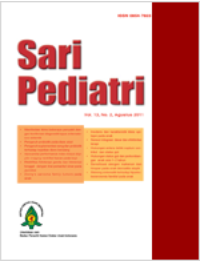Pengaruh Pemberian Omega-3 Terhadap Kadar C-Reactive Protein pada Remaja Obes Resistensi Insulin
Sari
Latar belakang. Obesitas berperan penting terhadap terjadinya sindrom metabolik yang dapat menyebabkan resistensi insulin,
dislipidemia, diabetes mellitus dan hipertensi yang akan meningkatkan risiko penyakit jantung koroner. Jaringan adiposa pada
obesitas akan memproduksi berbagai sitokin antara lain TNF-α dan IL-6 yang selanjutnya merangsang hati untuk menghasilkan
C-RP. Omega-3 mempunyai efek anti inflamasi, dapat meningkatkan sensitifitas insulin, mengurangi resistensi insulin, perlemakan
hati dan memperbaiki profil lemak serta menurunkan kadar C-RP.
Tujuan. Mengetahui pengaruh pemberian Omega-3 terhadap kadar C-RP pada remaja obesitas resistensi insulin.
Metode. Penelitian eksperimental dari November 2011 sampai Maret 2012 dengan disain pre and post-test group. Obesitas ditentukan
berdasarkan pengukuran indek massa tubuh (IMT) >p-95 WHO-NCHS, resistensi insulin menurut kadar homeostasis model assesmentinsulin
resistence (HOMA-IR) >3,16. Sampel terpilih diperiksa kadar C-RP sebelum dan sesudah pemberian Omega-3. Omega-3
diberikan selama 3 bulan dengan dosis 250 mg perhari. C-RP diperiksa secara Elisa dengan metode CMIA (chemiluminescent
Immunometriz assay), sensitivitas 0,01 mg/dL. Data diolah menggunakan paired t-test (α=0,05).
Hasil. Didapatkan 75 orang remaja obesitas dan 21 orang di antaranya (50,7%) mengalami resistensi insulin. Sebanyak 21 sampel
diuji, lebih dari separuh laki-laki (57,1% vs 42,9%). Rerata umur 16±0,68 tahun, rerata IMT 32,88±2,44 kg/m2. Rerata kadar
glukosa, insulin puasa dan HOMA-IR, masing-masing adalah 90,36±14,94 mg/dl, 20,89±4,19 μIU/L dan 4,52±0,89. Terdapat
penurunan kadar C-RP sebelum dan sesudah pemberian Omega-3, yaitu 8,69±5,46 mg/dL menjadi 6,41±4,77 mg/dL. Penurunan
ini bermakna secara statistik (p=0,018).
Kesimpulan. Konsumsi Omega-3 selama 3 bulan menurunkan kadar C-RP remaja obesitas resistensi insulin.
Kata Kunci
Teks Lengkap:
PDFReferensi
Subardja D, Cahyono HA, Moelyo AG. Obesitas pada
anak. Dalam: Batubara JRL, Tridjaja B, Pulungan AB,
penyunting. Buku Ajar Endokrinologi Anak. Jakarta:
UKK Endokrinologi Anak dan Remaja IDAI; 2010.
Fryar CD, Carroll MD, Ogden CL. Prevalence of obesity
among children and adolescents: United States, trends
-1965 through 2009-2010. Diakses pada 14 Juli
Diunduh dari : http://www.cdc.gov/nchs/data/hestat/
obesity_child_07_08/obesity_child_ 07_08.htm.
Kalupahana NS, Claycombe KJ, Moustaid-Moussa N. (n-3) fatty acids alleviate adipose tissue inflammation
and insulin resistance: mechanistic insights. Adv Nutr
;2:304–16.
Das UN. Is metabolic syndrome x an inflammatory
condition. Exp Biol Med 2002;227:989-97.
Freedman DS, Dietz WH, Srinvasan SR, Berenson GS.
The relation of overweight to cardiovascular risk factors
among children and adolescent: the Bogalusa Heart
Study. Pediatrics 1999;103:1175-82.
Despres JP. Abdominal obesity: the most prevalent cause
of the metabolic syndrome and related cardiometabolic
risk. European Heart J 2006;8:B4-12.
Giugliano D, Ceriello A, Esposito K. Are there specific
treatments for metabolic syndrome? Am J Clin Nutr
;87:8-11.
Drevon CA. Omega-3 fatty acids-metabolism and
mechanism of action of essential fatty acids. Diakses
pada Agustus 2011. Diunduh dari: http://Omega-3.
Möllers_orig.indd.
Simopoulos AP. Omega-3 fatty acids in inflamation and
autoimmune diseases. J Am Coll Nutr 2001;21:495–
Masterton GS, Pleuris JN, Hayes DC. Review article:
Omega-3 fatty acids a promising novel therapy for nonalcoholic
fatty liver disease. Aligment Pharmacol Ther
;10:1365-2036.
Caterina R, Bertolotto A, Madonna R, Schmidt EB. n-3
Fatty acids in the treatment of diabetic patients. Diabetic
Care 2007;30:1012-21.
Nobili V, Bedogni G, Aksi A, et al. Docosahexaenoid
acid supplementation decreases liver but content in
children with non-alcoholic fatty liver disease:double
blind randomized controlled clinical trial. Arch Dis Child
:2-4.
Muhammad K, Morledget, Saachar R. Treatment with -3
fatty acids reduces serum C-reactive protein concentration.
Clin Lipidol 2011;6:723-29.
Verduci E, Seaglioni S, Agosonic. The relationship of
insulin resistence with SNP 276 G>T at adiponectin
gene and plasma long-chain polyunsaturated fatty acids
in obese children. Pediatr Res 2009;66:346-8.
Weiss R, Kaufman FR. Metabolic complications of
childhood obesity: identifying and mitigating the risk.
Diabetes care 2008;31:S310-6.
Keskin M, Kurtoglu S, Kendirci M, Atabek ME, Yazici
C. Homeostasis model assesement is more reliable than
the fasting glucose/insulin ratio for assessing insulin
resistance among obese children and adolescents.
Pediatrics 2005;115:e500-3.
Ehtisham S, Crabtree N, Clark P, Shaw N, Barrett
T. Ethnic differences in insulin resistance and body
composition in United Kingdom adolescent. J Clin
Endocrinol Metab 2005;90:3963-9.
Goran MI, Bergman RN, Cruz MI, Watanabe RM.
Insulin resistance and associated compensatory responses
in African American and Hispanic children. Diabetes
Care 2002;25:2353.
Sinaiko AR, Steinberger J, Moran A, Hong CP, Prineas
RJ, Jacobs DR. Influence of insulin resistance and
body mass index at age 13 on systolic blood pressure,
triglycerides and high-density lipoprotein cholesterol at
age 19. Hypertension 2006;48:730-6.
Giron MD, Salto R, Hortelano P, Periago JL, Vargas
AM, Suarez MD. Increased diaphragm expression of
GLUT4 in control and streptozotocin-diabetic rats by
fish oil-supplemented diets. Lipids 1999;34:801–7.
Hussein J, Motafa E, El -Waseef M, El-Khayat Z, Badawy
E, Medhat D. Effect of Omega-3 fatty acids on erytrocyte
membrane in diabetic rats. Maacedonian J Med Sciences
;4:234-9.
Lopez CJ, Klunder MK, Azcarte AM, Huerta SF. Omega-3
polyunsaturated fatty acids reduce insulin resistance and trygliserides in obese children and adolescents [abstract].
Pediatric Diabetes 2013;14:377-83.
Brasil AR, Norton RC, Rossetti MB, Leoao E, Mendes
RP. C-reactive protein as an indicator of low intensity
inflammation in children and adolescents with and
without obesity. J Pediatr 2007;83:477-80.
Lyon CJ, Law RE, Hsueh WA. Mini review: adiposy,
inflammation and atherogenesis. Endocrinology
;144:2195-200.
Weiss R, Dziura J, Burgert TS. Obesity and metabolic
syndrome in children and adolescents. N Engl J Med
;350:2362-74.
Zieske AW, Tracy RP, McMahan A. Elevated serum
C-reactive protein levels and advanced atherosclerosis in
youth. Arterioscler Thromb Vasc Biol 2005;25:1237-43.
Tsitouras PD, Gucciardo F, Salbe AD, Heward C,
Harman SM. High Omega-3 fat intake improves insulin
sensitivity and reduces CRP and IL6, but does not affect
other endocrine axes in healthy older adults. Horm
Metab Res 2008;40:199–205.
Puglisi MJ, Fernandez ML. Modulation of C-reactive
protein, tumor necrosis factor-α, and adiponectin by diet,
exercise, and weight loss. J Nutr 2008;138:2293–6.
DOI: http://dx.doi.org/10.14238/sp17.1.2015.41-6
Refbacks
- Saat ini tidak ada refbacks.
##submission.copyrightStatement##
##submission.license.cc.by-nc-sa4.footer##
Email: editorial [at] saripediatri.org


Sari Pediatri diterbitkan oleh Badan Penerbit Ikatan Dokter Anak Indonesia
Ciptaan disebarluaskan di bawah Lisensi Creative Commons Atribusi-NonKomersial-BerbagiSerupa 4.0 Internasional.




